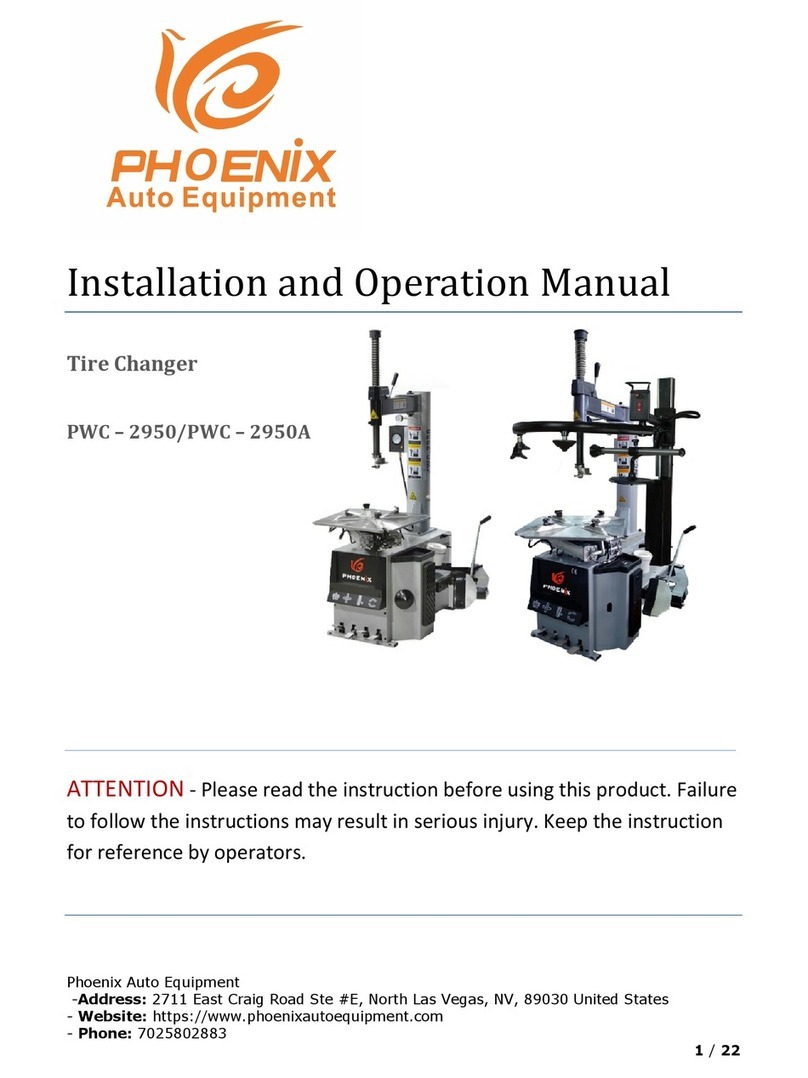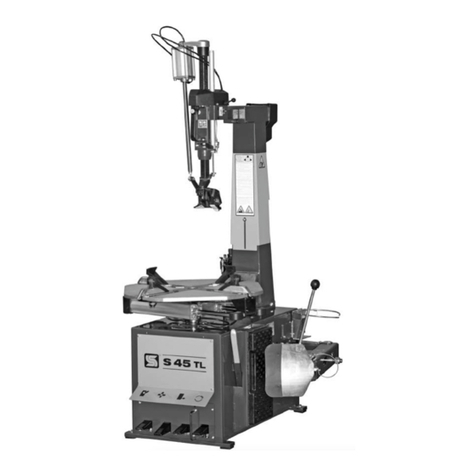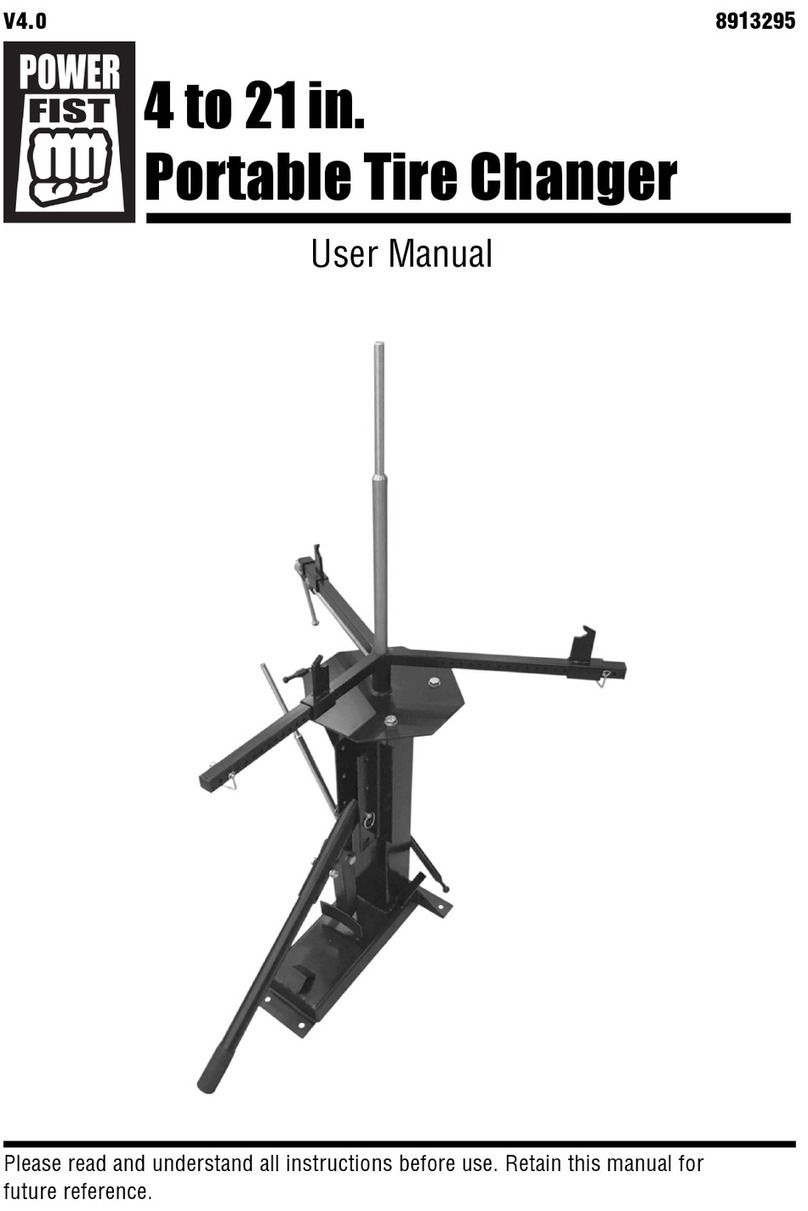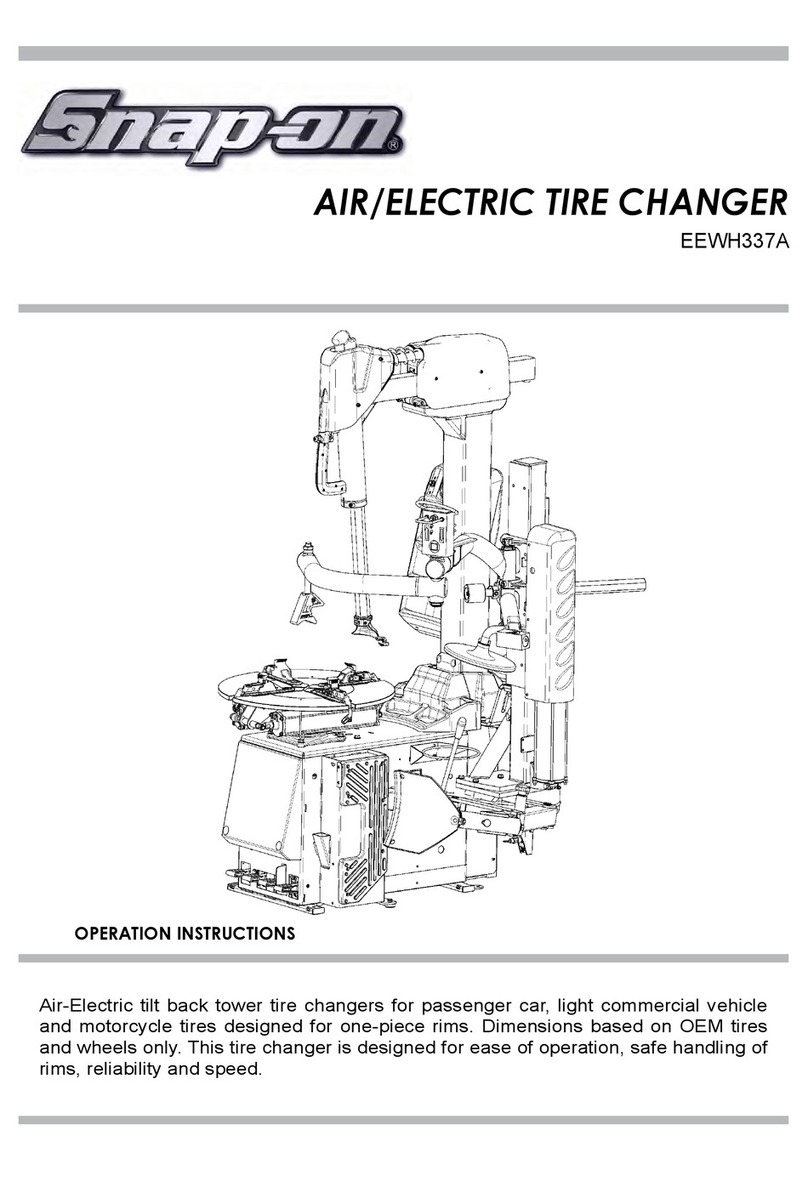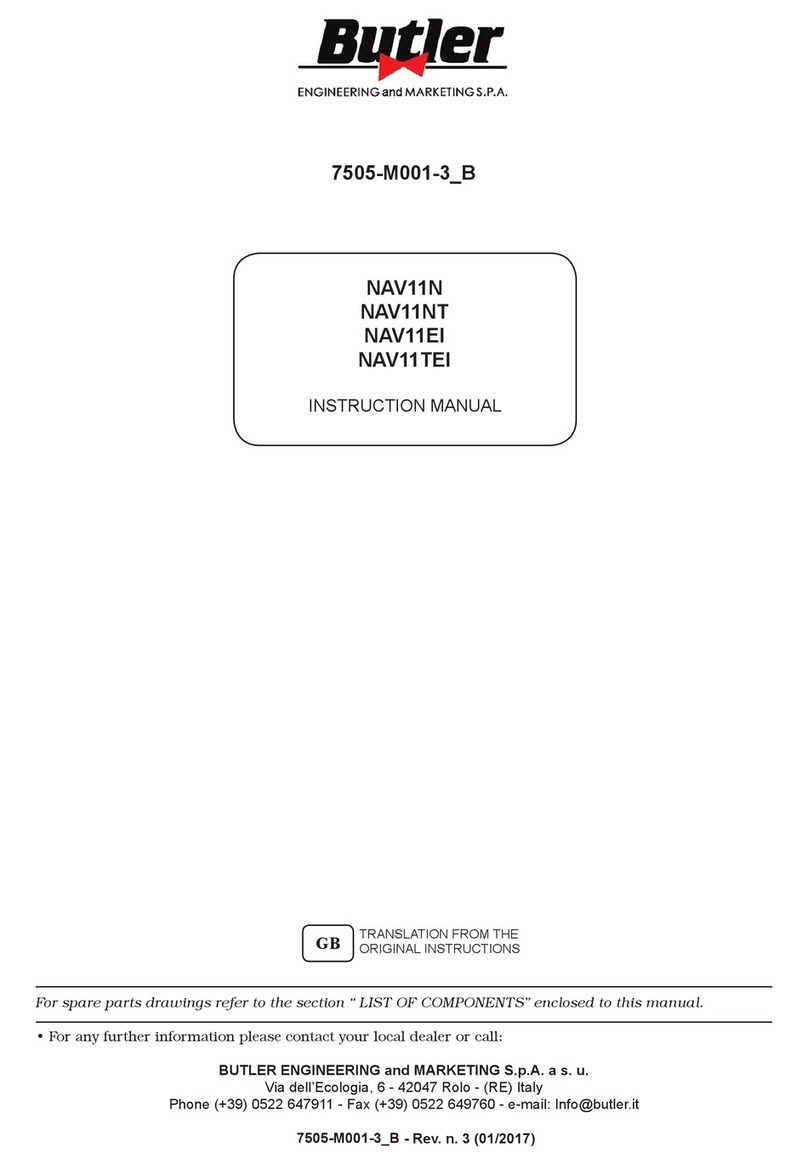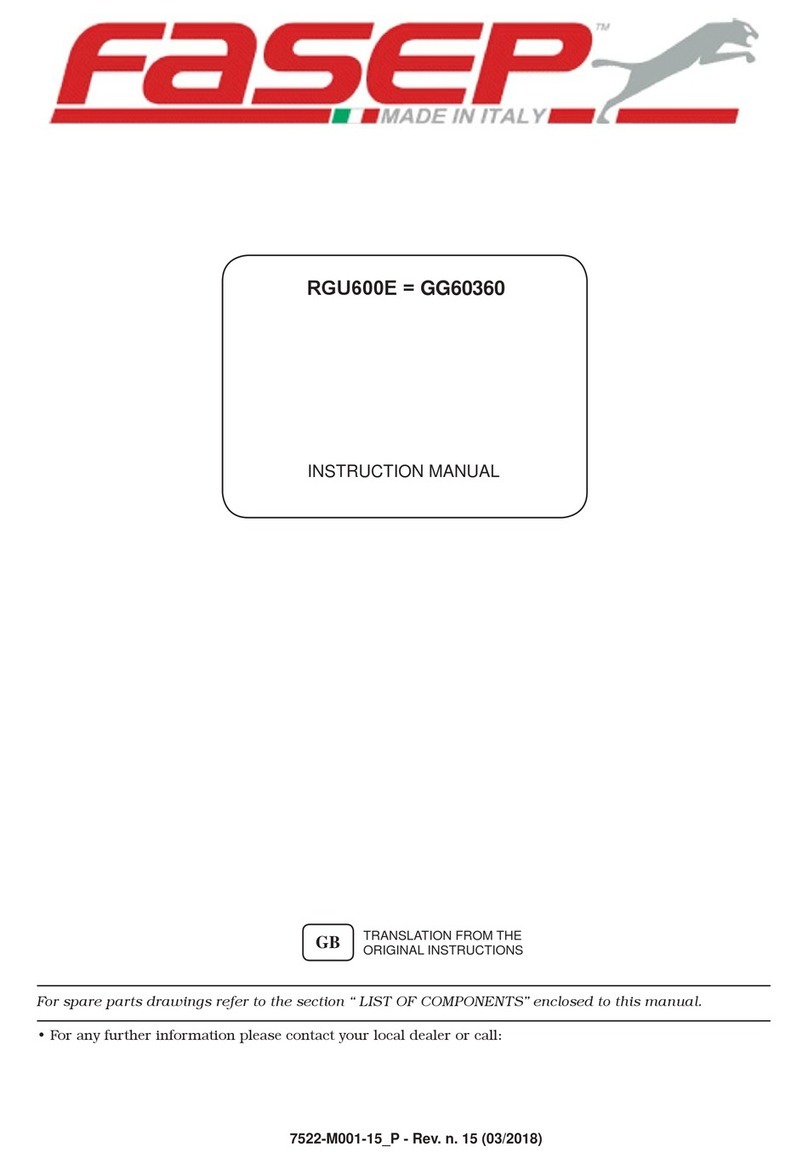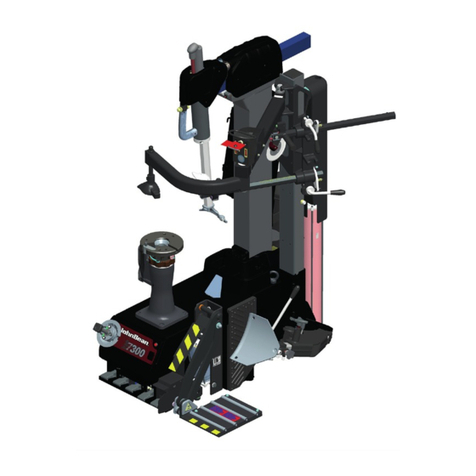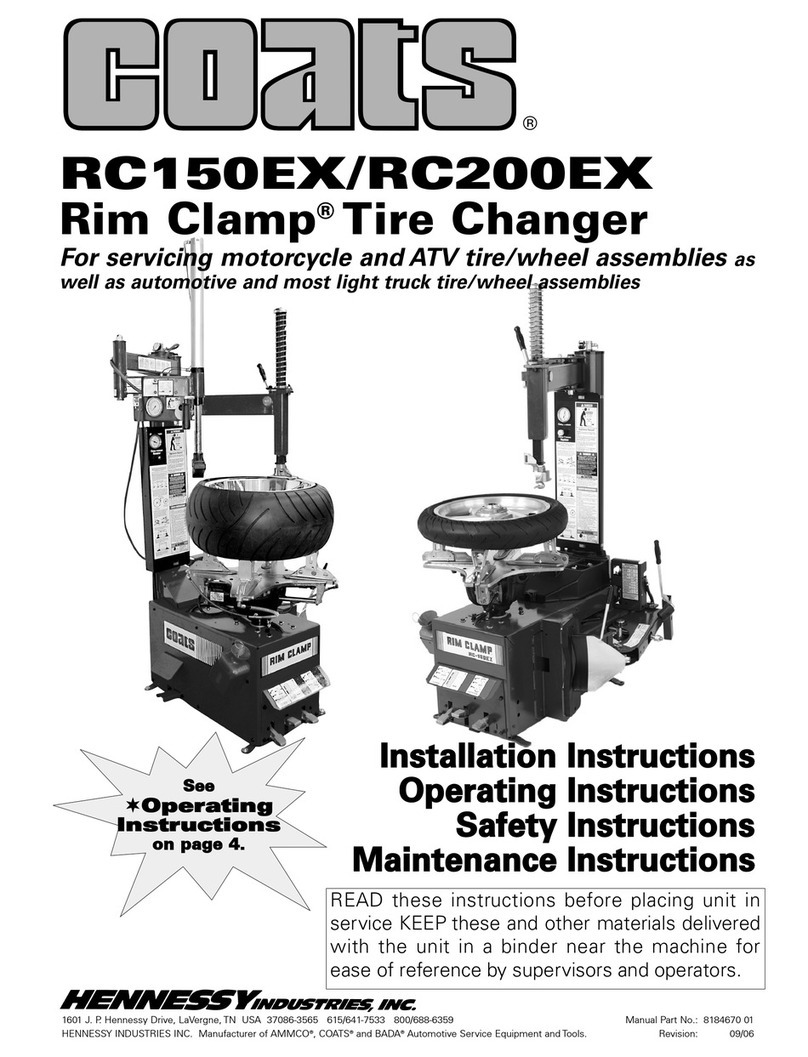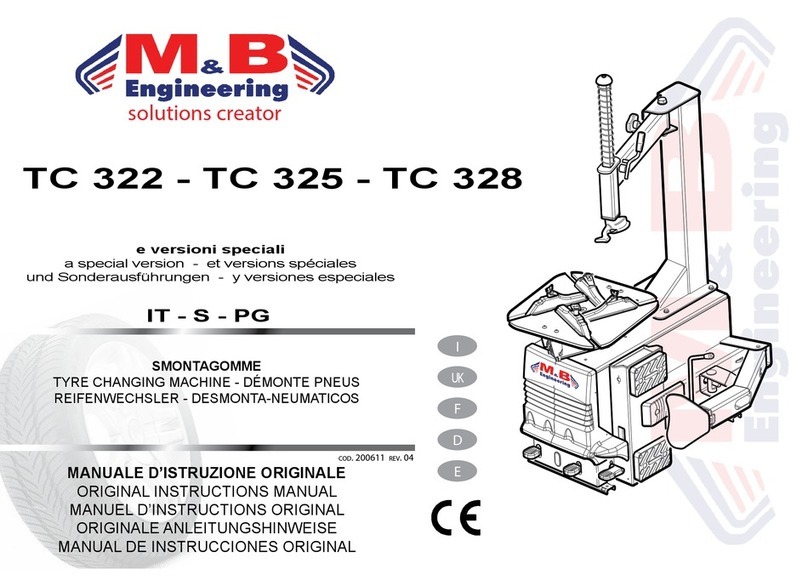Bosch TCE 4225 User manual

TCE 4225
de
Originalbetriebsanleitung
Reifenmontiermaschine
en
Original instructions
Tire changer
fr
Notice originale
Machine à monter les pneus
es
Manual original
Máquina para montaje de neumáticos
it
Istruzioni originali
Smontagomme
sv
Bruksanvisning i original
Däckmonteringsmaskin
nl
Oorspronkelijke gebruiksaanwijzing
Bandenmonteermachine
pt
Manual original
Máquina de montagem de pneus
pl
Instrukcją oryginalną
Zmieniacz opon
cs
Původní návod k používání
Stroj pro montáž a demontáž pneu-
matik
tr
Orijinal işletme talimatı
Lastik sökme ve takma makinesi
zh
ྟⱘᣛ
䕂㚢㺙䜡ᴎ

1 695 105 431 2010-02-16| Robert Bosch GmbH
22 | TCE 4225 |en
Contents
1. Symbols Used 23
1.1 Documentation 23
1.2 TCE 4225 23
1.3 Additional adhesive tags 23
2. Operator instructions 24
2.1 Important information 24
2.2 Safety information 24
2.3 Electromagnetic compatibility (EMC) 24
3. Product description 24
3.1 Expected use 24
3.2 Requirements 24
3.3 Delivery specification 24
3.4 Special accessories 24
3.5 Description of unit 25
3.6 Description of function 25
4. Initial commissioning 26
4.1 Unpacking 26
4.2 Assembly 26
4.2.1 Cover removal 26
4.2.2 Lifting of the tilting column 26
4.2.3 Column fixing 27
4.2.4 Positioning the vertical rod 27
4.2.5 Mounting the bead breaker arm 28
4.2.6 Mounting of the inflation device for
tubeless tires 28
4.2.7 Machine positioning 29
4.3 Pneumatic connection 30
4.4 Electrical connection 30
4.5 Check rotation direction 30
5. Operating instructions 31
5.1 Tire demounting 31
5.1.1 Preparations for demounting 31
5.1.2 Demounting 32
5.2 Tire mounting 32
5.2.1 Mounting preparations 33
5.2.2 Mounting 33
5.3 Inflation 34
5.3.1 Inflation with inflation pipe 34
5.3.2 Inflation with tubeless pneumatics
devices 34
5.4 Functioning anomalies 35
6. Maintenance 36
6.1 Suggested lube 36
6.2 Cleaning and servicing 36
6.2.1 Maintenance intervals 36
6.2.2 Condensate removal 36
6.2.3 Nebulizer oil refill 36
6.2.4 Change oil in the oil nebulizer 36
6.3 Spare and wearing parts 37
7. Decommissioning 37
7.1 Place change 37
7.2 Temporary decommissioning 37
7.3 Disposal 37
8. Technical data 38
8.1 TCE 4225 38
8.2 Dimensions and weights 38
8.3 Reach 38
8.3.1 Car wheels 38
8.3.2 Motorcicle wheels 38
9. Glossary 38

1 695 105 431 2010-02-16|Robert Bosch GmbH
Symbols used | TCE 4225 | 23 en
1. Symbols used
1.1 Documentation
Pictograms linked with the key words Danger, Warning
and Caution are warnings and always indicate an imme-
diate or potential hazard to the user.
Danger!
Immediate danger that could cause serious
personal injury or death.
Warning!
Potentially dangerous situation that could
cause serious personal injury or death.
Caution!
Potentially dangerous situation that could
cause personal injury or damage to property.
!Important – warns of a potentially hazardous situa-
tion in which the TCE 4225, the test sample or other
object in the vicinity could be damaged.
In addition to these warnings, the following symbols are
also used:
iInfo – In addition to these warnings, the following
symbols are also used.
Single-step procedure – instructions for a procedure
that can be completed in just one step.
Intermediate result – an intermediate result is dis-
played during a procedure.
"Final result – the final result is displayed at the end
of the procedure.
1.2 TCE 4225
Disposal
Old electrical and electronic devices, including
cables and accessories or batteries must be
disposed of separate to household waste.
1.3 Additional adhesive tags
!Respect all the safety instructions and danger war-
nings on the products and keep the related tags in
full readable conditions!
Mounting tool
Danger of crushing the fingers between the
mounting tool and the rim.
Mains tension
Danger of electrical shock when touching the
parts of the electrical system.
Bead breaker
Danger of crushing the limbs between the
bead breaker and the tire.

1 695 105 431 2010-02-16| Robert Bosch GmbH
24 | TCE 4225 | User informationen
2. User information
2.1 Important notes
Important information on copyright, liability and warran-
ty provisions, as well as on equipment users and com-
pany obligations, can be found in the separate manual
"Important notes on and safety instructions for Bosch
Tire Equipment". These instructions must be carefully
studied prior to start-up, connection and operation of
the TCE 4225 and must always be heeded.
2.2 Safety instructions
All the pertinent safety instructions can be found in the
separate manual "Important notes on and safety instruc-
tions for Bosch Tire Equipment". These instructions must
be carefully studied prior to start-up, connection and
operation of the TCE 4225 and must always be heeded.
2.3 Electromagnetic compatibility (EMC)
The TCE 4225 is a class A product as per EN 61 326.
3. Product description
3.1 Expected use
TCE 4225 is a modern tire-changer for use on cars. With
the aid of relevant accessories, it can also be used on
motorcycles.
iTCE 4225 has to be used exclusively for the specified
purpose and only in the functioning scope shown in
these instructions. Any other use different from that
specified has to be considered improper and there-
fore not allowed.
iThe manufacturer is not liable for any damage
caused by improper use.
3.2 Requirements
TCE 4225 has to be installed on an even surface made
of concrete or similar materials, and has to be firmly
anchored. A pneumatic connection is requested.
3.3 Delivery specification
Denomination Order code
TCE 4225
Bead lifting lever 1 695 102 683
Brush 1 695 100 123
Inflation manometer 1 695 103 996
Protection tab 1 695 101 608
Mounting tool cover 1 695 102 725
Bulb container 1 695 103 968
Bulb container support 1 695 104 083
3.4 Special accessories
Denomination Order code
Bead locking clamp 1 695 103 302
Upper wedge 1 695 103 216
Motor adaptors for 20" plate 1 695 105 438
Scooter adaptors for 20" plate 1 695 105 440
Roller 1 695 900 005
Object holder 1 695 900 003
Bead pressing device 1 695 103 261
20" motor bead breaker support 1 695 103 252
Motor tool kit 1 695 103 210
Bead breaker blade protection 1 695 102 090
Aisles protections for 20" plate 1 695 105 083
Tool tab protections (5 pieces) 1 695 101 608
TCE 200 1 695 900 002
Wheel hoisting device 1 695 900 025

1 695 105 431 2010-02-16|Robert Bosch GmbH
Product description | TCE 4225 | 25 en
3.6 Description of function
Below are reported the main functions of the listed
components of the TCE 4225:
3.5 Description of unit
On the TCE 4225 there are rotating and mo-
ving parts that could injure fingers and arms.
652006-01_Mi
2
4
3
1
5
7
8
13
12
14
15
18
17
16
6
9
10
1
11
21
24
22
19
20
23
Fig. 1: TCE 4225
Pos. Name Function
1 Locking flange rotation pedal Locking plate rotation:
clockwise (press down the pedal).
counter-clockwise (lift the pedal from bottom to top).
2 Bead breaker pedal Bead breaking arm activation.
3 Locking jaw pedal Opening and closing of the locking plate jaws.
4 Inflation pedal Operation of the automatic inflation device for tubeless tires and inflation pipe.
5 Bead breaking arm Bead breaking of the tire from the rim.
6 Bead breaking arm lever Positioning of the bead breaker blade.
7 Bead breaker blade Tire pressing for bead breaking operation.
8 Antiabrasive supports Tire support for bead breaking operations.
9 Column Horizontal jib arm and mounting tool support.
10 Cantilever horizontal arm Horizontal positioning of the mounting tool.
11 Locking knob Cantilever arm locking.
12 Vertical sliding rod Vertical positioning of the mounting tool.
13 Locking lever Locking of the vertically sliding rod.
14 Mounting tool Mounting and demounting of the tire from the rim
(with the help of the bead lifting lever).
15 Sliding roller Inserted in the mounting tool compartment, to avoid any friction between the
rim and mounting tool during the tire dismantling and assembly phases
For the alloy rims, a special plastic protection is arranged.
Locking plate, locking and rotation device (clockwise
and counter-clockwise) of the rim, pneumatically
driven by 2 cylinders, made of 4 movable lanes with
locking jaws for the internal and external locking of
the rim.
Column switch group, made up of a column switch
which supports the components necessary to dis-
mantle (and re-assemble) the tire from the rim: flag
horizontal arm (with locking knob), vertical sliding
rod (with locking lever), mounting tool to dismantle
(and re-assemble) the tire from the rim, with the aid
of the bead lifting lever.
Bead breaker, for the bead breaking of the tire from
the rim; it is made of the bead breaking arm pneu-
matically operated by a double effect cylinder, lever
for the arm positioning, antiabrasive supports for rim
support during bead breaking phases.
Pedal box, comprehends control pedals of the equip-
ment (locking flange rotation pedal, bead breaking
pedal, locking jaws pedal, inflation pedal).
Automatic inflation device for tubeless tires, made
by a compressed air circuit and an instantaneous
opening valve operated by the inflation pedal (the air
comes out from holes on the jaws, in order to seat
perfectly the bead of a tubeless tire).

1 695 105 431 2010-02-16| Robert Bosch GmbH
26 | TCE 4225 | Initial commissioningen
Pos. Name Function
16 Locking plate Locking and rotation of the rim.
17 Movable lanes Positioning of the locking jaws. Tubeless tire inflation.
18 Locking jaws Internal or external locking of the rim.
19 Compressed tank Inflates tubeless tires. Inflation is achieved through high pressure blowing that positions
the tire bead on the rim edge.
The air tank (compliant to UE 87/404) has a capacity of 18 litres of compressed air.
20 Inflation gauge Tire inflation check.
The manometer is compliant to CEE 87/217 directive.
21 Bead lifting lever Lifting of the tire edge in demounting and mounting phases.
22 Inflation pipe Tire inflation.
23 Deflation button Tire deflation.
24 Lubricator holder bulb Mounting paste container support
4. Initial commissioning
4.1 Unpacking
1. Remove the tape and the fixing clamps from the
pallet and the packaging cardboard.
iAfter unpacking check the integrity of TCE 4225 and
check that no components are visibly damaged. In
case of doubt do not proceed to start-up and con-
tact a qualified technician and/or your vendor.
2. Take out of the transport crate the standard accesso-
ries and the packaging materials.
iDispose correctly of packaging material, hand it over
to the designated collection points.
4.2 Assembly
4.2.1 Cover removal
1. Unscrew the 4 screws of the side cover and remove
the cover itself.
652004-02_Mi
4.2.2 Lifting of the tilting column
1. Get a 1 Mt lifting sling, DR 50 model (safety factor
6:1); wrap the sling around the cantilever arm and
lift the column with a hoist.
652002-16_Mi
2. Lean the column on the casing.

1 695 105 431 2010-02-16|Robert Bosch GmbH
Initial commissioning | TCE 4225 | 27 en
4.2.3 Column fixing
1. Fix the column to the casing with the screws contai-
ned in the provided accessories box.
652002-03_Mi
4.2.4 Positioning the vertical rod
1. Use the locking lever to unlock the vertical rod (1),
lift by about 10 cm and block it again.
2. Unscrew the cap on top of the rod with a wrench
(2).
652002-04_Mi
1
2
!Warning: when unlocking the rod keep a hand under-
neath it.
652002-05_Mi
3. Remove the rod; remove the spring and put again the
rod in its original seat, locking it at the end stop.
4. Insert the spring in the upper part of the rod and
screw again the cap with the wrench.
652002-06_Mi
Danger!
The spring could eject violently the rod from
its housing, thus it might be a serious danger
for the operator.
Carry out this operation carefully.

1 695 105 431 2010-02-16| Robert Bosch GmbH
28 | TCE 4225 | Initial commissioningen
4.2.5 Mounting the bead breaker arm
1. Remove the external elastic ring and take off the hin-
ge rod from its housing in the bead breaking arm.
2. Remove the self locking nut.
3. Insert the bead breaking arm and centre the joint pin
with the bead breaking cylinder, ensuring that the
flat part of the joint pin (1) is facing the outside.
6
52004-03_Mi
1
4. Insert the hinge-pin and put back in place the exter-
nal elastic ring.
5. Place the buffer spring on the provided tab and
screw in the bead breaking cylinder the self locking
nut.
Danger!
Wrong mounting of the bead breaking cylin-
der compromises machine functioning and
can be a serious danger for the operator.
During machine installation be sure that
the nut is correctly screwed in the bead
breaking cylinder rod (at least 10 mm).
652002-08_Mi
4.2.6 Mounting of the inflation device for tubeless
tires
1. Install the air tank behind the column by fitting the 2
provided screws.
652056-01_Mi
2. Insert the rubber pipe in the tank joint and fasten
the hose clamp.
652056-02_Mi
3. Connect the gauge support to the column with the 2
provided screws.
652006-02_Mi
2
3

1 695 105 431 2010-02-16|Robert Bosch GmbH
Initial commissioning | TCE 4225 | 29 en
4.2.7 Machine positioning
1. Put back in place the side door.
2. Loosen the two screws that fix TCE 4225 to the
pallet.
652004-04_Mi
Warning - damage risk!
The lifting belts can crush the flexible supply
pipes of the cylinder or damage the applied
parts of the TCE 4225.
Insert the lifting belts carefully.
3. Insert the appropriate lifting belts (length belt 1: 1
Mt, belt 2: 3 Mt), with sufficient capacity, as shown.
652004-09_Mi
!
1
2
4. Connect the supply pipes of the tank to the joint
located in the lower part of the tank (1).
5. Connect the air pipes to the rapid joints of the ma-
nometer, by inserting them in the appropriate holes:
the pipe coming from the front joint of the inflation
pedal (1) in the internal joint (nearer to the column),
the pipes coming from the rear joint of the inflation
pedal (2) in the external joint.
652006-03_Mi
1
3
2
3
2
652006-04_Mi
1740
500 1000
1300
500
Warning - tilting danger!
The barycentre of the TCE 4225 does not lie
in its centre.
It is necessary to lift the machine slowly.
4. Lift the TCE 4225 with a lift crane and install it in the
designed area respecting the minimum distances s
shown in the picture.

1 695 105 431 2010-02-16| Robert Bosch GmbH
30 | TCE 4225 | Initial commissioningen
iFor safe and ergonomic use of the TCE 4225 it is
recommended to leave a minimum of 500 mm space
from surrounding walls.
Warning - tilting danger!
During the functioning of TCE 4225 conside-
rable forces are exerted.
The TCE 4225 has to be fixed in at least 3
points on the floor (screw holes see chap.
4.2).
iIn each screw hole are placed shock absorbers to
reduce vibrations to the minimum.
5. Pre-arrange a suitable lubricator in the lubricator
holder bulb.
4.3 Pneumatic connection
1. Connect the TCE 4225 to the compressed air supply
unit.
652004-06_Mi
2. Adjust to a pressure between 8 and 12 bar.
Pull the red knurled screw (pressure reducing val-
ve) first upwards and then twist it to adjust ope-
rating pressure.
Check pressure on the manometer.
4.4 Electrical connection
1. Check the correspondence of the mains tension and
the tension shown on the identification tag.
2. Ask a qualified electrician to mount a connection
plug for single-phase or (depending on the tension
you have ordered ) three-phase current (see the
electrical connections diagram inside the electrical
panel).
iThe costs of arranging a mains protection device for
the plug are borne by the customer.
3. Protect the TCE 4225 according to specific national
rules.
4.5 Check rotation direction
!For a correct functioning of TCE 4225 it is extremely
important that, when the locking flange pedal shown
in Fig. 2 (1) is pressed, the locking flange (Fig. 2)
rotates clockwise.
652004-07_Mi
1
Fig. 2: Check rotation direction.

1 695 105 431 2010-02-16|Robert Bosch GmbH
Operating instructions | TCE 4225 | 31 en
5. Operating instructions
Warning - tire or rim damage danger!
Excessive pressure can e. g. result in cracks
(on the inside/outside) of the tire. The rim
can be scratched or deformed.
Read the Wdk publications available in
German and English! (www.wdk.de: moun-
ting/demounting instructions – criteria
catalogue)
Inner temperature of the tire must be at
least 15 °C (only in case of RFT/UHP).
Read the Wdk publications available
in German and English! (www.wdk.de:
mounting/demounting instructions – tire
overheating)
Adjust pressure to the type of tire.
Use the plastic protections on the types of
rim that need it.
!Before demounting or mounting operations it is ext-
remely important to collect all the rim and tire data.
In this way it will be possible to know in advance the
mounting, the pressure and the required accesso-
ries!
iRemove all the balancing weights from the rim.
iIf the semi drop centre of the rim is placed in the
inside part it is necessary to insert a cover to the
locking jaws (see chap. 3.3) on the flanged plate,
because in this case the rim leans on its side during
rotation.
5.1 Tire demounting
iRead the Wdk publications available in German and
English!
(www.wdk.de: mounting/demounting instructions).
5.1.1 Preparations for demounting
!Avoid valve damage!
1. Pull out the needle from the valve.
The air is discharged completely from the tire.
2. Place the wheel on the floor, close to the antiabrasi-
ve supports of the beadbreaker; to put the blade (1)
close to the bead pressing the bead breaker control
pedal (2). The operation has to be carried out in dif-
ferent points of the wheel (rotating it manually) until
the bead doesn't come off completely.
iLubricate the side of the tire and the hump with
mounting paste to make the bead breaking opera-
tions easier.
652004-08_Mi
21
3. Repeat the operation on the opposite side of the
wheel.
Warning – limb injury danger!
During operation of the bead breaking arm,
be careful in order to avoid that the limbs are
not crushed between the tire and the bead
breaker.
Do not insert limbs between the tire and
the bead breaking arm.
Warning – damage risk for RFT or UHP tires!
Cracks in case of operation on cold tire. Tire
explosion in case of high speed.
Inner temperature of the tire must be at
least 15 °C.
Read the Wdk publications available in Ger-
man and English! (www.wdk.de: mounting/
demounting instructions – tire overheating)
Before mounting put the tire in a temperate
room.

1 695 105 431 2010-02-16| Robert Bosch GmbH
32 | TCE 4225 | Operating instructionsen
5.1.2 Demounting
Warning – hand injury danger!
During locking plate rotation there is a risk of
crush injuries.
Do not insert the fingers between the tire
and the rim.
1. Turn counterclockwise the locking knob to unlock
the sliding rod.
2. For external locking of the rim press the locking
jaws opening pedal to prepare the jaws in the open
position;
iIn case of internal locking the jaws must be prepared
in the closing position.
3. Place the wheel on the locking plate
4. Exerting with the hand a pressure on the rim, press
the locking jaws closing pedal in order to lock it.
5. Lubricate with mounting paste the side of the tire till
the edge of the rim.
6. Bring the mounting tool close to the rim until the
roller touches the edge of the rim.
iLift the locking lever of the vertical rod to carry
out vertical spacing of the mounting tool and arm
blocking
iUse the locking knob of the horizontal arm to adjust
mounting tool spacing from the tab (the recommen-
ded spacing is 3 mm).
7. Insert the bead breaking lever between the mounting
tool and the bead of the rim. To make this operation
easier bring the bead in the part opposite to the
mounting tool inside the semi drop centre of the rim.
iIn case RFT or UPH tires the use of accessories like
clamps, wedge or of the TCE 200 bead breaker is
suggested.
8. With the provided bead breaking lever lift the edge
of the tire and lean it on the mounting tool tab (1).
9. Press the rotation pedal to rotate clockwise the lo-
cking plate, until complete ejection of the bead from
the rim.
652002-13_Mi
1
iIn case of tires with tube, use the locking knob to
unlock the horizontal arm and move it to free the
working area and extract the tube.
10. Repeat the same operations to make the second
bead come out.
5.2 Tire mounting
Danger of car accidents caused by damaged
rims or tires!
In case of tire or rim damage during moun-
ting dangerous or even lethal situations may
occur during driving.
The operator has to be specifically trained.
Do not exert excessive forces on the tire or
the rim, adjust the slow rotation speed.
Use a sufficient quantity of mounting
paste.
In case of anomalies, e.g. suspicious noi-
ses, stop mounting immediately.
For mounting of critical rim/tire combina-
tions, read the Wdk publications available
in German and English!(www.wdk.de:
mounting/demounting instructions – crite-
ria catalogue).

1 695 105 431 2010-02-16|Robert Bosch GmbH
Operating instructions | TCE 4225 | 33 en
5.2.2 Mounting
Warning – hand injury danger!
During locking plate rotation there is a risk of
crush injuries.
Do not insert the fingers between the tire
and the rim.
1. Rotate the locking flange and bring the valve bet-
ween 2 o'clock and 4 o'clock position (the mounting
tool is at 12 o'clock position).
2. Bring the mounting tool close to the rim until the
roller touches the edge of the rim.
iLift the locking lever of the vertical rod to carry
out vertical spacing of the mounting tool and arm
blocking
iUse the locking knob of the horizontal arm to adjust
mounting tool spacing from the tab (the recommen-
ded spacing is 3 mm).
3. Lay the tire bead on the lower left edge of the moun-
ting tool tab.
5.2.1 Mounting preparations
Warning – damage risk for RFT or UHP tires!
Cracks in case of operation on cold tire. Tire
explosion in case of high speed.
Inner temperature of the tire must be at
least 15 °C.
Read the Wdk publications available in Ger-
man and English! (www.wdk.de: mounting/
demounting instructions – tire overheating)
Before mounting put the tire in a temperate
room.
1. Lubricate with mounting paste the inside of the rim
in correspondence of the edge and of the shoulder
of the rim and of the semi drop centre.
2. Lubricate the two tire beads with mounting paste.
3. Lean the tire oblique on the rim.
4. While holding the bead in the semi-drop centre press
the rotation pedal and keep turning the locking plate
until the upper tire bead has passed close to the
mounting tool (1) and it has gone under the edge of
the rim.
652002-14_Mi
1
iBe sure that the bead is inserted in the drop centre
of the rim in order to eliminate bead yields; in order
to make his operation easier, it is suggested, during
rotation of the locking plate, to assist with a bit of
pressure the insertion of the bead in the rim.
iIn case of tires with tube, use the locking knob to
unlock the horizontal arm and move it to free the
working area; place the rim so that the valve hole of
the tube is positioned at about 90° degrees relatively
to the mounting tool position and insert, if needed,
the tube.
5. Repeat the same operations for the insertion of the
second bead.
iIn case of RFT or UPH tires, in order to hold the
bead inside the semi drop centre, the use of acces-
sories like clamps, wedges or of the TCE 200 bead
breaker is suggested.
6. Press the locking jaw pedal to release the rim.

1 695 105 431 2010-02-16| Robert Bosch GmbH
34 | TCE 4225 | Operating instructionsen
5.3 Inflation
Inflation can generate potential danger
situations. The operator has to carry out the
necessary precautions in order to guarantee
operational safety.
!Safety device:
To protect the operator from eventual dangers that
can occur during tire inflating on the locking plate,
the TCE 4225 has been equipped with a valve that
limits operational pressure to 3,5 bar.
5.3.1 Inflation with inflation pipe
1. Screw the valve element.
2. Connect the inflation pipe to the tires' valve.
3. Operate on the inflation pedal to inflate the tire until
it reaches the nominal pressure.
5.3.2 Inflation with tubeless pneumatics devices
1. Insert the inflation pipe in the tire valve.
2. Lift the tire upwards with both hands, allowing the
air (that comes out from the holes in the jaw) to
come in between rim and tire.
3. Press the inflation pedal until end stop, to let the
air come out from the jaws and, in the meantime,
release the tire to allow bead seating.
!If the tire bead doesn't "seat" repeat accurately the
above mentioned operations.
4. Once the tire bead is seated, carry on the inflation
operation by holding the inflation pedal pressed in
its intermediate position, until the desired pressure
is reached.

1 695 105 431 2010-02-16|Robert Bosch GmbH
Operating instructions | TCE 4225 | 35 en
5.4 Functioning anomalies
In the following table all the possible anomalies and their correspondent remedies are listed.
Other supposable functioning anomalies are mainly of technical nature and have to be verified and resolved by
qualified technicians.
In any case contact the assistance service of the authorized vendor of Bosch equipment.
iTo speed up intervention it is important to tell during the phone call the data reported on the identification
plate (tag on the back of the TCE 4225) and the type of malfunction.
!Any intervention on the electrical, hydraulic or pneumatic system, has to be performed exclusively by qualified
technicians which are properly trained.
Anomalies Causes Remedies
The locking plate does not turn in any of the two directions. 1. The network plug is
not connected.
2. The network plug is not
correctlyconnected.
3. The tension does not corres-
pond tothe prescribed value.
1. - 2. Check if the network plug
is correctly inserted in the so-
cket and check connection.
3. Check the tension oftension.
When the locking flange pedal is pressed
down, the locking plate turns clockwise.
1. Phases inversion du-
ringplug connection.
1. Invert the 2 phases in the
network plug (qualifiede-
lectrician is required).
The locking plate transmits insufficienttorque (low force). 1. Wrong network tension.
2. Wrong phases con-
nection in the plug.
3. Loosen transmissionbelt.
1. Check the correspon-
dence of the network tensi-
on and the tension shown
on theidentification plate.
2. Check that the phases in the
plug are correctly connected.
3. Pull the transmission belt.
The locking plate does not lock the rim correctly. 1. The pneumatic system is not
connected to the TCE 4225.
2. Insufficient pressure in-
the pneumatic system.
3. The pressure reducing valve is
closed or incorrectly adjusted.
1. Connect the pneumaticsystem.
2. Adjust pneumatic pressu-
re to the correct value.
3. Open or adjust correctly-
the pressure reducingvalve.
The bead breaker force is not enough for bead breaking. 1. The pneumatic system is not
connected to the TCE 4225.
2. Insufficient pressure in-
the pneumatic system.
3. The pressure reducing val-
ve is closed or wrongly ad-
justed (valid for the versions
that use this kind of device).
4. The tire is not com-
pletely deflated.
1. Connect the pneumaticsystem.
2. Adjust pneumatic pressu-
re to the correct value.
3. Open or adjust correctly-
the pressure reducingvalve.
4. Remove the valve ele-
ment from the valve until com-
plete deflation of the tire.
The manometer does not indicate the correct pres-
sure when operating the inflation pedal.
1. The connecting pipes
of the manometer are in-
correctly connected.
1. Invert the connection of the con-
necting pipes of the manometer on
the joints of the inflation pedal.

1 695 105 431 2010-02-16| Robert Bosch GmbH
36 | TCE 4225 | Maintenanceen
6. Maintenance
6.1 Suggested lube
Component Lube Standard
Gearbox ESSO Spartan EP460 ISO 460
DIN 51502-CLP
ISO 34-98-CC
Pneumatic system (con-
ditioning assembly)
ESSO FEBIS K 32 ISO VG 32
Tab. 1: Lubricants table.
!The manufacturer is not liable for any damage
caused by use of lubes different from those shown in
the table.
6.2 Cleaning and servicing
Before any cleaning or maintenance interven-
tion, disconnect the TCE 4225 by means of
the main switch and disconnect the network
plug.
Before any cleaning or maintenance interven-
tion, disconnect the pneumatic system of the
TCE 4225.
To guarantee full efficiency of the TCE 4225 and to
ensure functioning without anomalies it is essential to
clean the machine regularly and carry out periodical
maintenance.
Maintenance has to be carried out by the operator
in accordance with the manufacturer's prescriptions
shown here below.
6.2.1 Maintenance intervals
Maintenance
weekly
monthly
annual
Clean the mechanical moving parts,
spray them with nebulized oil or cheros-
ene and lube with appropriate grease
x
Remove the condensate from
the filter assembly. x
Check oil level in the oil nebulizer. x
Check transmission belt tensio-
ning in order to avoid its sliding. x
Check the oil level in the gearbox and keep it
always between minimum and maximum level. x
Change oil in the oil nebulizer. x
6.2.2 Condensate removal
1. Turn left the red button placed in the lower part of
the water separator.
2. Remove the accumulated condense by pressing the
same button.
3. Turn back in previous position the red button placed
in the lower part of the water separator.
6.2.3 Nebulizer oil refill
1. Disconnect pneumatic connection.
2. Unscrew the tank cap on the oil nebulizer.
3. Top up oil (see lube table).
652002-15_Mi
6.2.4 Change oil in the oil nebulizer
1. Disconnect pneumatic connection.
2. Unscrew the tank cap on the oil nebulizer.
3. Discharge oil and dispose it (see chap. 7.3).
4. Top up with new oil (see lube table).

1 695 105 431 2010-02-16|Robert Bosch GmbH
Decommissioning | TCE 4225 | 37 en
6.3 Spare and wearing parts
Denomination Order code
Mounting tool adhesive tag 1 695 100 982
Electrical tension adhesive tag 1 695 100 789
Bead breaker adhesive tag 1 695 100 983
Aisles protections for 20" plate 1 695 105 083
Bead breaker blade screw 1 695 103 347
Mounting tool 1 695 102 647
Tool tab protections (5 pieces) 1 695 101 608
Mounting tool cover 1 695 102 725
Bead breaker blade 1 695 100 897
Front bead breaker support 1 695 100 643
Rear bead breaker support 1 695 100 654
7. Decommissioning
7.1 Place change
Procedure:
1. Disconnect electrical connection.
2. Disconnect pneumatic connection.
3. Dismantle the column switch and lean it at the side.
4. Follow what shown for first start up (see chap. 4.2).
5. Fix again the TCE 4225 with its four screws on the
pallet (see chap. 4.2).
iIn case of sale or transfer of TCE 4225, all the docu-
ments included in the consignment volume has to be
integrally handed over together with the equipment.
7.2 Temporary decommissioning
If the TCE 4225 is going to be stopped for a limited
period of time or if the equipment is not being used
for other reasons, always disconnect the network plug
from its socket!
It is suggested to clean accurately the TCE 4225, also
its tools and accessories, and carry out a protection
treatment (e.g. spraying of a thin oil film).
7.3 Disposal
Disconnect the TCE 4225 from the mains tension
and take off the power supply cable.
Oil are water pollution risk fluids and have to be
disposed of in accordance with the rules in force.
Disassemble the TCE 4225, order the materials ac-
cording to the category it belongs to and dispose of
them according to the rules in force.
TCE 4225 complies to the rules of the Euro-
pean directive 2002/96/CE (directive on the
disposal of electrical and electronic waste).
Electric and electronic devices which are out
of order, together with their cables, accesso-
ries, accumulators and batteries, have to be
disposed of separately from household waste.
For disposal of such products, use the
available return and collection systems.
The correct disposal of the TCE 4225
makes it possible to avoid environmental
damage and to put at no risk the life of
people.

1 695 105 431 2010-02-16| Robert Bosch GmbH
38 | TCE 4225 | Technical dataen
8. Technical data
8.1 TCE 4225
Function Specifications
Maximum noise level. 70 dB
Bead breaking cylinder force. 2600 N (2,6 t)
Compressed air supply 8 – 12 bar
Power supply tension depending on the cho-
sen tension (see iden-
tification plate)
8.2 Dimensions and weights
Function Specifications
TCE 4225 (H x W x D) 1740 x 1000 x 1300 mm
Net weight 213 kg
Gross weight 252 kg
8.3 Reach
8.3.1 Car wheels
Function min / max
Tire width 3" – 10"
Maximum tire diameter 1000 mm
Rim diameter (internal locking) 13" – 23"
Rim diameter (external locking) 10" – 20"
8.3.2 Motorcicle wheels
Function min / max
Tire width 3" – 7"
Maximum tire diameter 1000 mm
Rim diameter 14" – 23"
iTo operate on motorbike wheels it is necessary to
install the motorbike wheel fitting device, available
upon request (see chap. 3.4).
9. Glossary
Rim, structure and names
652001-26_Rf
1
1
3
4
3
2
D
Fig. 3: Rim
1 Rim edge
2 Rim shoulder
3 Hump (lifted edge)
4 Semi drop centre
D Rim diameter
RFT
Run Flat Tyre, tire with emergency functioning features,
normal wheel and spare wheel at the same time.
TCE
Tyre Change Equipment, abbreviation for tire changer.
UHP
UltraHighPerformance tires, name of the brand of a tire
for high speeds.
wdk
German rubber industry association
(registered association).
Table of contents
Other Bosch Tyre Changer manuals
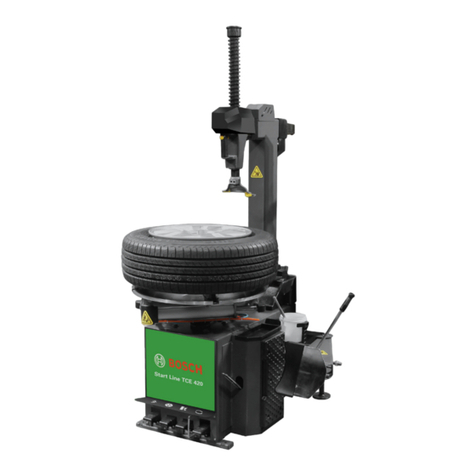
Bosch
Bosch Start Line TCE 420 Setup guide

Bosch
Bosch TCE 5210 Setup guide

Bosch
Bosch TCE 4510 User manual

Bosch
Bosch TCE 330 User manual

Bosch
Bosch TCE 60 User manual
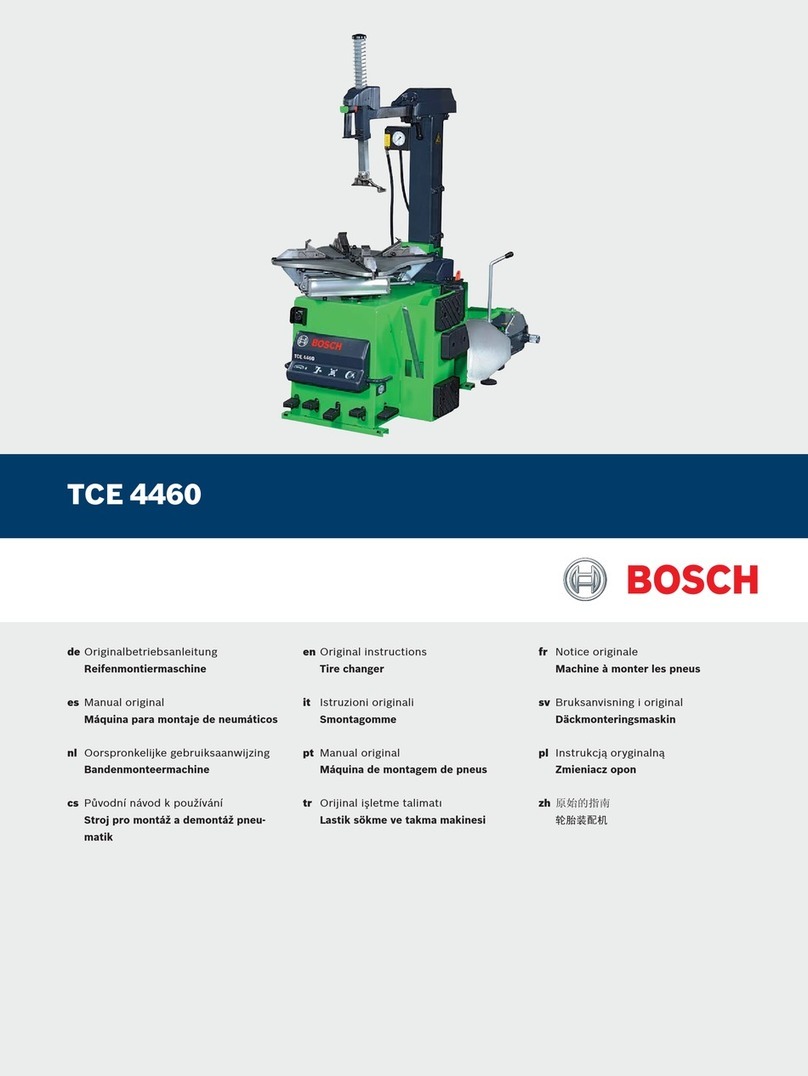
Bosch
Bosch TCE 4460 User manual
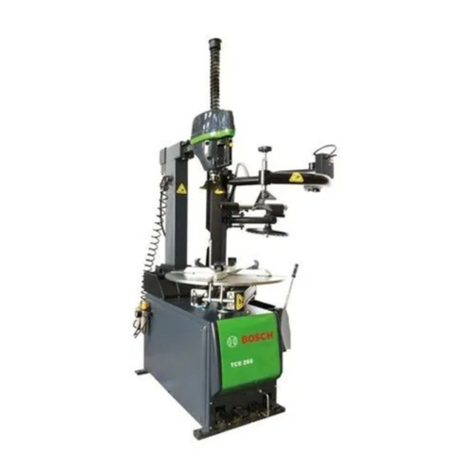
Bosch
Bosch TCE 260 User manual

Bosch
Bosch TCE 4540 User manual

Bosch
Bosch Start Line TCE 420 User manual
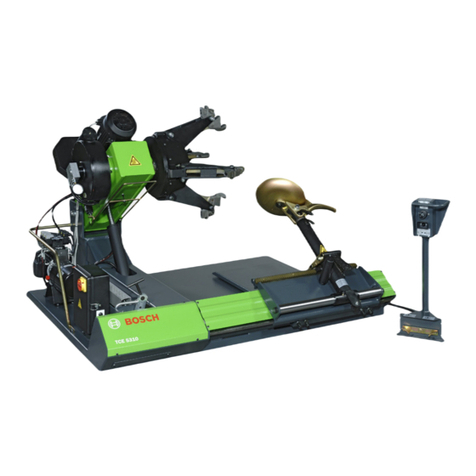
Bosch
Bosch TCE 5310 User manual
Popular Tyre Changer manuals by other brands

Hofmann
Hofmann monty 4400 Operation manual

Fasep
Fasep RASE.2247 instruction manual

Würth
Würth 9501006290 Instruction & maintenance manual
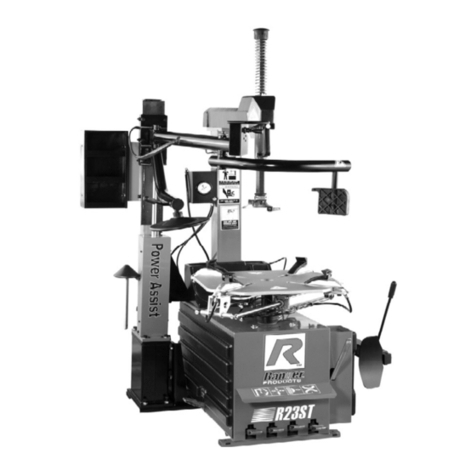
Ranger Products
Ranger Products R23 Installation and operation manual

BOXER
BOXER KING 5600 Service manual

Branick Industries, Inc.
Branick Industries, Inc. 5500 Installation, Operation and Repair Parts Information
